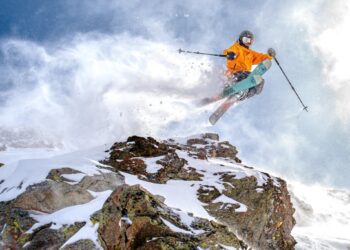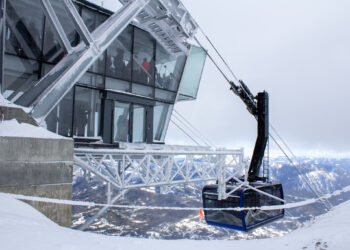By Evelyn Boswell MSU News Service
BOZEMAN – College students from Maryland to California will gather May 16 to
18 at Montana State University for a national competition related to an
upcoming NASA satellite mission.
Weather permitting, nine teams will climb onto the roof of AJM Johnson Hall
with optical instruments they designed and built to answer questions about
the sun and other scientific topics, said Randy Larimer, deputy director of
the Montana Space Grant Consortium and director of the National Student
Solar Spectrograph Competition. In case of bad weather, the students will
work inside the building.
Students may use their spectrographs to look at the sun and choose solar
features they want to examine, Larimer said. They could otherwise use the
sun as a light source for any scientific question that interests them. In
Montana alone, scientists are using spectroscopy to learn about meth houses,
pine tree health, and water vapor in the Earth’s atmosphere.
Each member of the four winning teams will receive a $3,000 scholarship from
NASA, Larimer said. They will also have the opportunity to watch NASA’s
Interface Region Imaging Spectrograph (IRIS) satellite launch at Vandenberg
Air Force Base in California. The launch is scheduled for December.
MSU solar physicist Charles Kankelborg–who leads MSU’s efforts on IRIS–said spectrographs gather incoming light and separate out the wavelengths.
Prisms are a simple form of spectrograph that breaks apart visible light,
producing rainbows on walls and other surfaces. Other types of spectrographs such as IRIS break apart ultraviolet light, which is invisible to
humans.
The Montana Space Grant Consortium, based at MSU, was selected to organize
and host the competition as a way to help fulfill NASA’s requirement that
the IRIS mission include education and public outreach, Larimer said. The
competition, in fact, is the second of three national spectrograph
competitions the consortium is holding at MSU. The first, held last year,
was a pilot. The third will be held next year, with the possibility of 30
teams competing.
The National Student Solar Spectrograph Competition is meant especially for
smaller colleges that may not have much activity in aerospace or optics,
Larimer said. Since the competition has four categories, it gives more
teams a chance to win, he added. Those categories are best science, best
build, best design, and best presentations. The presentations will be three
10-minute talks covering design and build, outreach and scientific results.
Thirteen teams started the competition this year, and nine teams will be in
Bozeman for the 2012 competition. Montana teams this year will come from
Flathead Valley Community College in Kalispell, Montana Tech in Butte, MSU
in Bozeman (three teams) and the University of Montana in Missoula.
Out-of-state teams will come from Harding University at Searcy, Ark.,
Montgomery College in Rockville, Md., and San Diego State University in
California.
Kankelborg, who is one of the judges for the competition, said IRIS consists
of a telescope and spectrograph working together to help scientists figure
out how energy is transferred through the sun’s atmosphere. This knowledge
will have many applications, he added.
Ultraviolet radiation from the solar
atmosphere is highly variable and drives important chemical processes in
Earth’s upper atmosphere. The chromosphere is a conduit for energy that
accelerates the solar wind, a stream of charged particles from the sun that
–during intense episodes–has the potential to severely damage satellites,
global power grids, GPS systems and disrupt airline travel. The U.S.
government considers the understanding and predicting of solar winds and
other “space weather” so important to the country’s economic, transportation
and energy infrastructures that it formed the Space Weather Prediction
Center as part of the National Oceanic and Atmospheric Administration. MSU,
an internationally recognized leader in solar physics, contributes to the
effort to understand and predict space weather.
The Harvard-Smithsonian Center for Astrophysics built the telescope that
allows the IRIS spectrograph to observe the sun. MSU supplied the
spectrograph optics and participated in its design. The spectrograph team is
headed by Lockheed Martin.
Once it’s launched, the telescope will face the sun at all times, orbit the
Earth at least three years and gather images from the sun’s chromosphere and
transition region, Kankelborg said. The transition region is invisible from
the ground. During a total eclipse of the sun, the chromosphere is seen as a
thin red layer of atmosphere just above the bright yellow photosphere.
Kankelborg wrote in the April issue of Physics Today that the IRIS mission
will observe the chromosphere in ultraviolet light and the transition region
in far-UV. He said the smallest observed elements of the chromosphere are
spicules, which are thin shafts of plasma that can be found all over the
face of the sun. They rise and fall at tens of kilometers per second, and
come in two classes based on size and speed.
Other current or recent members of MSU’s IRIS team are senior research
engineer Larry Springer, who worked at Lockheed Martin before coming to MSU;
professor Joseph Shaw, postdoctoral researchers Sarah Jaeggli and Nathan
Pust, research engineers Keith Mashburn and Christy Dunn; and Stefan
Eccles, a 2011 graduate in physics. Team members come from the Department of
Physics and the Department of Electrical and Computer Engineering.
The National Student Solar Spectrograph Competition is free and open to the
public. Events take place from 8 a.m. to 5 p.m. May 16 to 18 with a special
public outreach event from 3 to 5 p.m. Friday, May 18, in the atrium of the
EPS Building.













